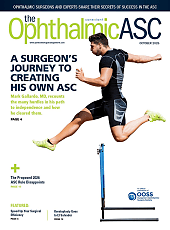STAT
TRACKER
The Latest Data on IOL Use
|
Use of foldable posterior implants: silicone vs. non-silicone |
||
| Q3 2001 | Last 4 Quarters | |
| Total posterior foldable implants | 623,896 | 2,375,265 |
| non-silicone foldable | 364,886 (58.5%) | 1,308,893 (55.1%) |
| silicone foldable | 259,010 (41.5%) | 1,066,372 (44.9%) |
| The higher percentage of non-silicone foldables implanted in Q3 2001 vs. in the last 4 quarters indicates that the use of acrylics, hydrogels, hydrophilic acrylics and collagen/collamer blends is outpacing the use of silicone at an increasing rate. The introduction of a variety of new non-silicone materials greatly contributes to this trend. | ||
|
Posterior implants: use of 1-piece vs. 3-piece |
||
| Q3 2001 | Last 4 Quarters | |
| Total posterior implants | 663,058 | 2,569,684 |
| 1-piece | 251,557 (37.9%) | 783,304 (30.5%) |
| 3-piece | 411,501 (62.1%) | 1,786,380 (69.5%) |
| This is a dynamic market segment. The number of implantations of 1-piece lenses nearly doubled, from 21.8% of the posterior lens market in Q4 2000 to 37.9% in Q3 2001. | ||
|
Percentage of surgeons who use injectors to insert foldable IOLs |
|||
| High volume surgeons | Low volume surgeons | All surgeons | |
| Yes | 71.2% | 56.6% | 62.7% |
| No | 28.8% | 43.4% | 37.3% |
| Data from Q3 2001. | |||
|
Surgeon response to "which IOL feature is most important in reducing lens epithelial cell proliferation?" |
|||
| High volume surgeons | Low volume surgeons | All surgeons | |
| Lens material | 42.1% | 37.2% | 39.2% |
| Shape of lens edge | 43.5% | 42.6% | 43% |
| Texture/finish of lens edge | 4.7% | 10.7% | 8.2% |
| Other | 9.7% | 9.5% | 9.6% |
| Data from Q3 2001. | |||
About this data: The information in this installment of Stat Tracker was provided by Health Products Research Inc., Vision Information Services - The IOL Report. The IOL Report is a quarterly recall survey conducted among U.S. ophthalmic surgeons. Respondents to the third quarter 2001 survey totaled 1,027. For this quarter, total IOL implants have a margin of error of ±2.3% (or ±3.9% at 90% confidence level).








